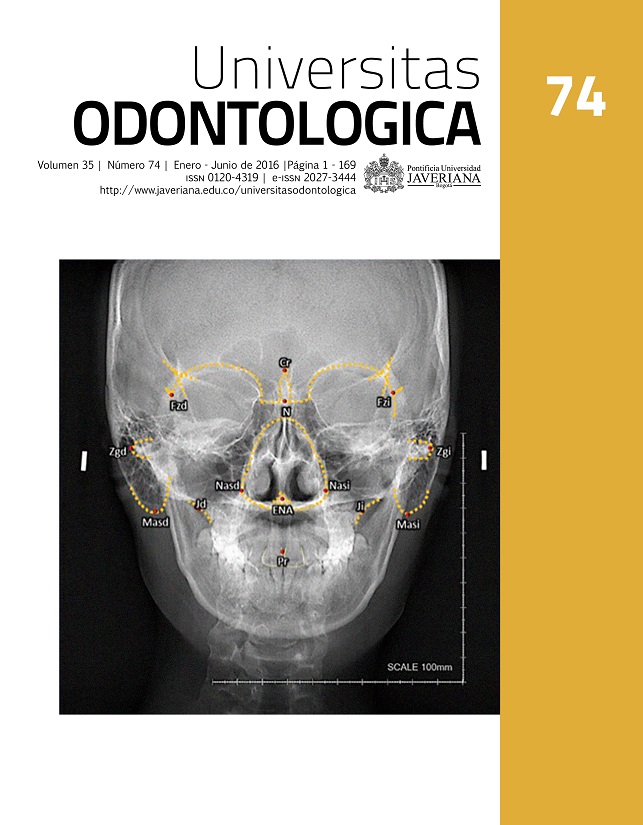Abstract
ABSTRACT. Background: is necessary to consider which parameter should stablish the central incisor inclination. Purpose: The main objective of the present study was to appraise the possible concordance between the maxillary incisors inclination and the facial axis, the articular eminence inclination and the palatal functional inclination of the maxillary incisors. Methods: We perform an observational cross sectional study with 315 cone beam tomographic images from 63 healthy patients. Then a single technician carried out all the measures. The statistical analysis included T test, regression, and intra-class correlation. Results: There´s no statistical correlation between the articular eminence angle and the maxillary incisor inclination, nonetheless the facial axis present a low correlation and the functional palatal surface of the maxillary incisors present a high correlation with the inclination of the upper incisors. Conclusion: We conclude that the maxillary inclination could be answer by others functional factors such as neutral zone, occlusal function, and facial biotype except the articular eminence inclination. On the other hand, the facial axis should be taken into account in orthodontic planning treatment and could be a key factor to stablish the maxillary incisor inclination.
Pokorny PH, Wiens JP, Litvak H. Occlusion for fixed prosthodontics: A historical perspective of the gnathological influence. J Prosthet Dent. 2008; 99: 299-313.
Ricketts RM. Variations of the temporomandibular joint as revealed by cephalometric laminagraphy. Am J Orthod. 1950;(36): 877-92.
Okeson JP. Management of temporomandibular disorders and occlusion. 7th edition. St. Louis, MO: Elsevier Mosby; 2013.
Dawson PE. Functional occlusion: from TMJ to smile desing. St. Louis, MO: Mosby; 2009.
McIntyre GT, Millett DT. crown-root shape of the permanent maxillary central incisor. Angle Orthod. 2003; 73: 710-15.
Tong H, et al. Mesiodistal angulation and faciolingual inclination of each whole tooth in 3-dimensional space in patients with near-normal occlusion. Am J Orthod Dentofacial Orthop. 2012; 141: 604-17.
Shen Y, Hsu J, Wang Y, Huang H, Fuh L. The Collum angle of the maxillary central incisors in patients with different types of malocclusion. J Det Sci. 2012; 7: 72-6.
Knosel M, et al. On the interaction between incisor crown-root morphology and third-order angulation. Angle Orthod. 2009; 79: 454-61.
Katsavrias G. Changes in articular eminence inclination during the craniofacial growth period. Angle Orthod. 2002; 72: 258–64.
Cortés-Reyes E, Rubio-Romero JA, Gaitán-Duarte. Métodos estadísticos de evaluación de la concordancia y la reproducibilidad de pruebas diagnósticas. Rev Colomb Obstetr Ginecol. 2009; 60(4): 247-55.
Gokalp H, Turkkahraman H, Bzeizi N. Correlation between eminence steepness and condyle disc movements in temporomandibular joints with internal derangements on magnetic resonance imaging. Europ J Orthod. 2001;(23): 579-84.
Dincer M, Darendeliler N, Soylu R. The biomechanical relation between incisor and condylar guidances in deep bite cases. Turk Ortodonti Dergisi. 1998; 11(3): 281-94.
Schierz O, John MT, Schroeder E, Lobbezoo F. Association between anterior tooth wear and temporomandibular disorder pain in a German population. J Prosthet Dent. 2007; 97: 305-9.
Río-Highsmith J, Grano de Oro-Cordero E, Aguayo-Ruiz G. Selección de pilares en implanto prótesis. RCOE. 2002; 7(5): 507-17.
Acosta A, Salso RA, Iglesias M. Utilización de pilares angulados en la rehabilitación protésica sobre implantes. Presentación de un caso. Multimed. 2011; 15(2).
Bidez MW. Transmisión de fuerzas en implantes odontológicos. J Oral Implant. 2002; 18: 264-274.
This journal is registered under a Creative Commons Attribution 4.0 International Public License. Thus, this work may be reproduced, distributed, and publicly shared in digital format, as long as the names of the authors and Pontificia Universidad Javeriana are acknowledged. Others are allowed to quote, adapt, transform, auto-archive, republish, and create based on this material, for any purpose (even commercial ones), provided the authorship is duly acknowledged, a link to the original work is provided, and it is specified if changes have been made. Pontificia Universidad Javeriana does not hold the rights of published works and the authors are solely responsible for the contents of their works; they keep the moral, intellectual, privacy, and publicity rights.
Approving the intervention of the work (review, copy-editing, translation, layout) and the following outreach, are granted through an use license and not through an assignment of rights. This means the journal and Pontificia Universidad Javeriana cannot be held responsible for any ethical malpractice by the authors. As a consequence of the protection granted by the use license, the journal is not required to publish recantations or modify information already published, unless the errata stems from the editorial management process. Publishing contents in this journal does not generate royalties for contributors.


